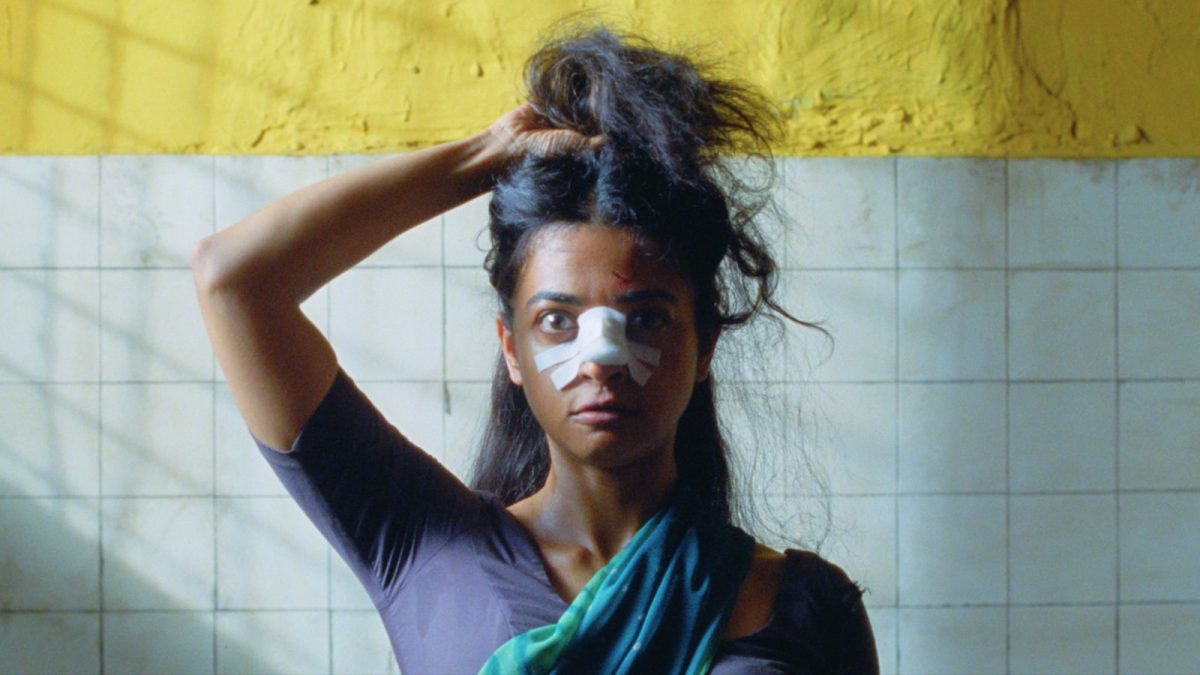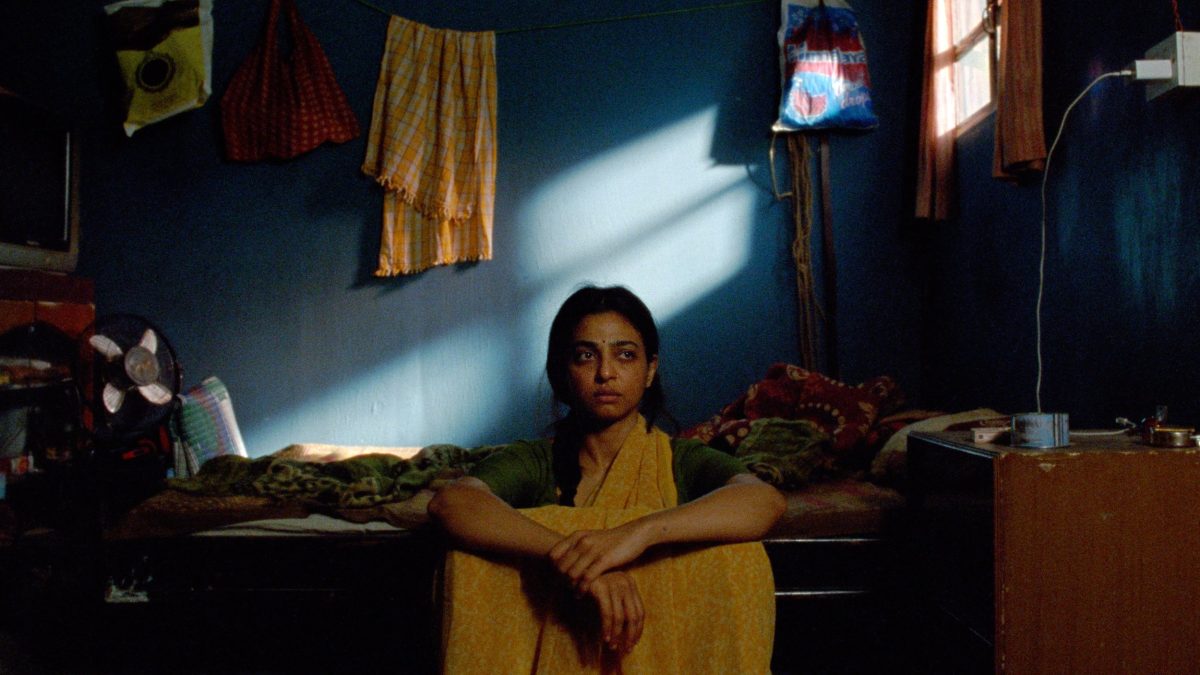The feature-length directorial debut of British short filmmaker and cinematographer Karan Kandhari, “Sister Midnight” (2025), on the surface reads like textbook international festival bait—exactly the kind of India-set film global audiences love to indulge in. Nominated for the Caméra d’Or at Cannes in 2024 and winner of the Next Wave Best Feature at Fantastic Fest, the film is steeped in exactly the kind of issues we’re right to scrutinize in works of this nature.
The dialogues feel like they were piped through Google Translate, and it’s baffling that seasoned performers like Radhika Apte, Ashok Pathak, and Chhaya Kadam didn’t seem to flinch. The laborious attempt to orchestrate a black-comedic ballad leads to a third act that drags itself out. What we get is a half-westernised film unable to hold the full cultural weight of the country it so desperately wants to embody.
Yet, what pulls it all together is its fiercely intelligent stylistic design. The aesthetic palette feels like one of those new-age, chaotic graffiti, where Raja Ravi Varma heroines are spliced with punk collage. Even the music needle-drops hold the frame together, orchestrating the chaos the film so breathlessly leans into. There’s a clear dissonance between language and content, but you’re still compelled to pause, either to willingly immerse in the endlessly interpretable fantasia of mental breakdown or to witness the film’s layered awareness of the gendered economics of survival.
At the heart of it is Radhika Apte’s masterful comeback as Uma, not defined by resilience, inventiveness, or familiarity, but by the film’s own refusal to be boxed in. She remains unlikeable, unreadable, untouchable, and ultimately unkillable—an ethos that pulses through the writing with such clarity that, if you shed your inhibitions, you’ll find yourself deeply, weirdly engaged. And still, the unsignposted, genre-coded liberation “Sister Midnight” enacts comes with its own perceptual friction. As I read, write, and explain the film here for you, I’m also learning to make sense of it myself. So, here’s an attempt.
Sister Midnight (2025) Plot Summary and Movie Synopsis:
What happens when Uma arrives?
Uma and Gopal, the bride and groom, sit on a night train heading toward Mumbai. Uma peers out from the window, watching the cramped spaces unfold beneath towering skyscrapers as they inch closer to the city. When they reach the makeshift hutment—one among many aligned in the quiet of night—Uma begins removing her ornaments to change. But the moment she removes the pallu of her saree, Gopal bolts outside, startling her. After she changes, Gopal returns and gestures for her to step out so he can change.
Uma takes a cigarette packet, goes out, lights one, and stands still, smoking, silently processing the absurdity of it all. When Gopal falls asleep, she slips off the bed, her hair dishevelled, possibly to explore the neighbourhood. She’s chased by a barking dog and finds herself at a quiet open area with a red-lit stage, decorated with wilting flowers and scattered paper cups—leftovers from a wedding or some forgotten festivity.
What upsets Uma the next morning?
Uma wakes up to the buzz of incessant honking and Gopal’s absence. She opens the door to find the jhuggi sitting right on a noisy roadside. Startled, she shuts the door, changes into a saree, and sits quietly, alone. She steps out again, only to step into cow dung with her bare feet. Just then, Sheetal, a middle-aged neighbour chopping onions nearby, casually asks if she has butter. Uma is absurdly petrified and rushes back inside. That night, Gopal barges in, slams the door, and collapses drunk in the corner by the almirah.
Uma quietly rifles through his pockets, grabs the money, and heads out to buy biscuits and snacks, munching them through the night. The next morning, she confronts him furiously for leaving her alone in a strange place. Gopal says he went to work. She snaps back—does she look like a chutiya to him? He mumbles that his friends were asking about the wedding party. As he readies for work, Uma silently extends her hand. He places what little money he has into her palm and leaves.
How do Uma and Gopal manage their finances?
As Uma sits outside, observing the street, a neighbouring woman stares at her. She furiously clinks her bangles until the woman looks away. With the money she has, she buys rice, lentils, and vegetables, but quickly exhausts herself while cooking, since she doesn’t know how. After Gopal leaves again, Uma knocks at Sheetal’s door, asking for a knife. Sheetal jokes: Does she want the one to cut yams or to cut balls? Uma returns with a large knife but is clueless about how to use it. When Gopal comes home, he sees her hands covered in flour. As he sits beside her, she faints on his shoulder, murmuring that there’s no dinner tonight.
The next morning, they argue—there’s no money left. Gopal says the cash was meant to last a week. Uma snaps that she knows how to count, just not how to run a household. Gopal takes chalk and draws a weekly expense chart on the floor, showing her how to keep track and save. She calls him smart. The next day, she again knocks at Sheetal’s, this time asking to learn cooking. Sheetal obliges, telling her that men eat anything with chilli and salt if it’s hot enough. Gopal enjoys what Uma cooks. Uma returns to Sheetal, wanting to learn more. But Sheetal waves her off, saying there’s nothing else—just soak, boil, and fry the daal.
What happens at the cousin’s wedding?

That night, Uma tells Gopal the breeze feels nice and suggests they go for a walk and smoke. She asks how his day was. He says it was alright, maybe. She remarks that this must be their first proper night of marriage—the first night barely counted. The scene fades as Uma reminds him to ask her the same question.
Later, they argue again—Uma insists they need to step out. Gopal mentions a cousin’s wedding, but Uma laughs him off, saying they need to go somewhere on Sunday. When Sunday comes, they oversleep, get off at the wrong stop, and return. On the way back, Uma hears the clinking bangles of the bus women and gets hers broken by a confused local locksmith.
They attend the cousin’s wedding, where relatives gossip: two village idiots who ended up with each other. Everyone else rejects Gopal. That night, they argue violently. Uma almost throws away her wedding saree, but Gopal stops her. She confronts him about their unconsummated marriage, and they finally sleep together.
How does Uma’s mental state decline?
The next morning, Uma walks into a building, steals some flowerpots from the ground floor, and later becomes unsettled when she sees herself reflected among them in the mirror. She heads to Khar station and from there to Marine Drive, which momentarily lifts her spirits, until she spots two strangers crying nearby. She lands a cleaning job at a shipping company. Uma is often dropped halfway home by Sher Singh, the office peon. She finds occasional comfort in Sheetal’s company, joining her on brief walks, but Sheetal begins to distance herself, irritated by Uma’s clinginess.
Soon, Uma’s nights spiral: her ears buzz with static, her body shrivels from hunger. She befriends a group of roadside kinnars she meets in quiet corners. Her routines dissolve—she falls asleep at odd hours, sometimes collapsing mid-sweep. One night, overcome by hunger, she snatches a goat in the street and bites its neck. She throws the goat and herself into a garbage pile, only to return soon after, dishevelled, broken. She forcibly kisses Gopal before falling asleep. Often seen draped in a shawl, dark glasses on, Uma walks the street, cursing neighbouring women who try to make small talk.
Sister Midnight (2024) Movie Ending Explained:
What happens to Gopal?
Her delusions spike. She catches random birds, apologises to them, bites them in half, and wraps their bodies in white cloth, storing them in drawers. Uma hallucinates—the dead goat racing wildly, men chasing it, birds erupting from under the bed, bursting through the walls. She tries explaining her state to Gopal—how she can’t eat—but they’re interrupted by a knock. It’s a co-worker and his wife, inviting them for a seaside outing. They go. Uma takes the couple’s dog for a stroll and lets it wander off. She informs them, then flees with Gopal. The two admit they’re not normal and form an odd friendship. That night, they tried to have sex.
Also Read: Top 10 Witch Movies
The next morning, Uma again sees birds fly from under the bed, but she smiles. Until the realisation hits—she killed Gopal last night by biting him. In panic, she dresses his corpse and stops going outside. As Diwali approaches, she wraps his body in fairy lights and flowers, lighting diyas around him. She imagines goats flooding their home and tries to silence them. When the nosy neighbour finds out, Uma kills her too, chops her into pieces, and dumps her body in the same place she once discarded her “goats.”
How does Uma finally leave?
She wraps Gopal’s corpse in white robes, paints marigolds black, and lines them by his side. With help from a truck driver—coaxed by her kinnar friend—she travels to the city outskirts and cremates him on a mound. An ascetic finds her there, smears Gopal’s ashes on himself and her, and drinks a cold drink. Later, at a tea stall, Uma watches a black-and-white samurai film on TV while sipping tea. She is hit by a car and rescued by Buddhist nuns. They feed her, which she refuses. She says she doesn’t believe in God. They reply—they don’t either. She uses their phone to call Sheetal.
At sunset, she returns to her locality, only to see men with fire torches burning her home. Birds fly out from it. She knocks at Sheetal’s. One of the men tries to torch her, but she escapes. She’s kidnapped by a group in a car—it’s Sheetal, her husband, and the kinnar friend. The mob arrives, branding her a monster. She tells them it’s easier being a monster than a human, terrifying them, including the policeman and the priest who come to exorcise her.
They hand her the things she asks for. She boards the train. A co-passenger sees the bandage on her nose and asks what happened. She says she got a new face. In the bathroom, she puts on black nail polish, black lipstick, a black saree, and sunglasses. Smoking a cigar, she watches the hallucinated goats chasing the train from outside.
Sister Midnight (2025) Movie Themes Analyzed:
The Urban Afterlife

As a snapshot of its city and culture, “Sister Midnight” is a Mumbai film made, quite specifically, for people like me—those who don’t like Mumbai films. I’m weary of the romanticisation of dampness, and of the writerly impulse to reframe everyday exhaustion as some kind of exacting escape. In that sense, the film’s choice of protagonist makes absolute sense: a woman perched at the absolute margins, so dislocated that even domestic help is a rung too high for her.
Uma’s descent is mapped across Mumbai’s ever-shifting urban fragments, refracted through the visual and rhythmic grammar of a full-bodied genre film. In this retelling, the fragmented settings become set-pieces in their own right—the kholi where she stays, the desolate red-lit wedding stage she stumbles into on her first night, the office terrace where she eventually sleeps. Together, they form a necropolis of survival, memory, and madness.
Of course, there’s the familiar idea: the city waits for no one. But here, that cliché rots into something more brutal. The city doesn’t enable. It excludes by default, unless you “make it” in absolutes. That enabling, celebratory Mumbai is reserved for the mythic, not the marginal. Uma’s psyche is metabolised by this phantom terrain—the more she tries to fit in, the more the city swallows and ejects her. And if this same spiral had happened in her Marathi village or some satellite town, things would’ve played out differently.
The fall would’ve been cleaner: either she’d be publicly burned alive, or the town would crowd around her, pressuring her into conformity. In either case, there would be a parental figure—something Mumbai (or Pune) simply cannot offer. The city has companions, not caretakers. Gopal, the emotionally and physically distant husband; Sheetal, a companion with whom Uma might have entertained a romance; and the kinnars, who offer moments of warmth. If Mumbai can be imagined as a mother at all, she is either a foster mother or a fed-up stepmother, tired of her illiterate child.
That’s also why we don’t see Uma’s mental illness develop in a linear or structured way. It creeps in like the city’s own logic: fugitive, gendered, informal, fragmented. Even the surrounding textures—the nosy neighbouring woman who ends up dead—are shaped by the surveillance culture and small violences of the lower-middle-class urban gaze. “Sister Midnight” doesn’t give Mumbai the beauty pass; it leaves her in the shadows, where ghosts, delusions, and failed women fester.
Madness, Myth, and the Feminine Monstrous
In the Bhakti era of Indian history—beginning in the Dravidian South during the early medieval period—we hear of Karaikkal Ammaiyar. A stunningly beautiful woman, so devoted to Shiva that she could conjure mangoes through sheer devotion. Her husband, unsettled by this divine obsession, fled to Madurai and remarried. When Ammaiyar discovered the cause of his abandonment, she prayed to become gaunt and grotesque—unwanted, undesired, feared—so that her devotion would never again be interrupted by worldly interference. She became a spectral ascetic, walking on her hands, laughing, singing, loving Shiva in her own terrifying way.
This story finds strange echoes in “Sister Midnight.” Uma’s declaration—that it’s hard to be human—feels like a postmodern update to that same logic. When the priest and policeman cower before her, it isn’t because she asks to be feared, but because the gaze of a woman no longer performing sanity is mythic in itself. For a second, she resembles a village deity—a terrifying kuldevi in a city that doesn’t believe in gods anymore.
Karan Kandhari makes a critical choice here. He resists the clinical vocabulary of mental health, opting instead for the esoteric, the ecological, the symbolic. This isn’t to undercut illness—it’s to reframe it outside the tidy boxes of DSM labels. Uma is both cursed and chosen. She doesn’t get “exorcised”—she performs her own ritual. She dresses her dead husband, builds the pyre, smears herself with his ashes, and lands in a monastery where the nuns themselves don’t believe in God.
The film turns mental illness into a quiet, furious theology—mapping not just a woman’s unravelling, but the entire legacy of how cultures struggle to interpret her. It dares to believe that breakdown is not just biological, but mythic.
And yet, it’s all undercut with black comedy. To read Uma solely as a divine or folkloric figure would be a misstep. Her arc is also darkly absurd. Birds are flying out from under the bed. Hallucinated goats. Random animal consumption. At any moment, you feel like she might shake hands with Nosferatu, and the film will flip into a globetrotting horror opera. She’s a modern-day yakshi—but one who’s had enough, who bites back, and who rewrites her own myth without permission.








